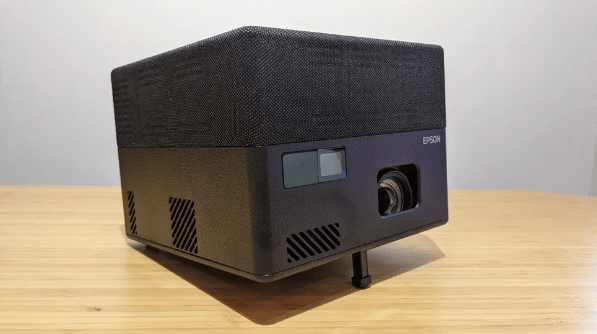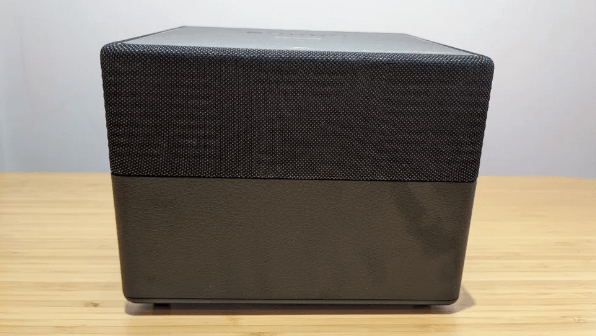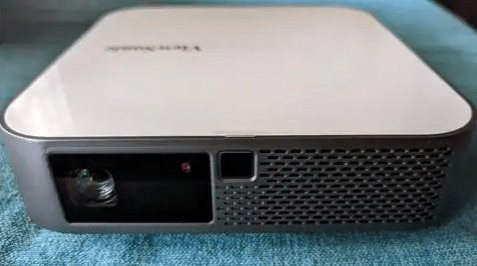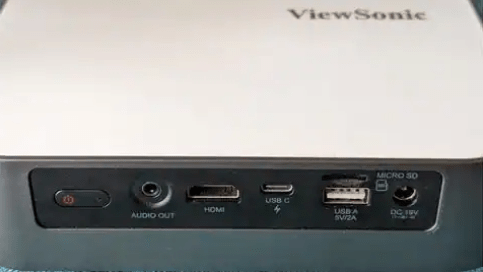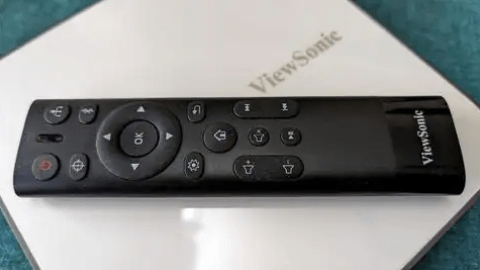At gagadget.com, your trust is our priority. We follow strict quality standards in our research, tests, and analysis of video projectors, to give you the best experience. Learn more
Epson EF12 vs Viewsonic M2e
Hey everyone, it's Jim from Gagadget. Today, I'm comparing two popular portable projectors: the Epson EF12 and the ViewSonic M2e. Both offer 1080p resolution, auto focus, built-in speakers, and a compact design for easy setup and transportation. But they also have some key differences in brightness, color performance, throw ratio, and more.
I've spent many hours evaluating both projectors in various environments, from home theater sessions to office presentations. In this in-depth Epson EF12 vs ViewSonic M2e shootout, I'll share my hands-on experiences to help you decide which one best suits your portable projection needs. Let's get started!
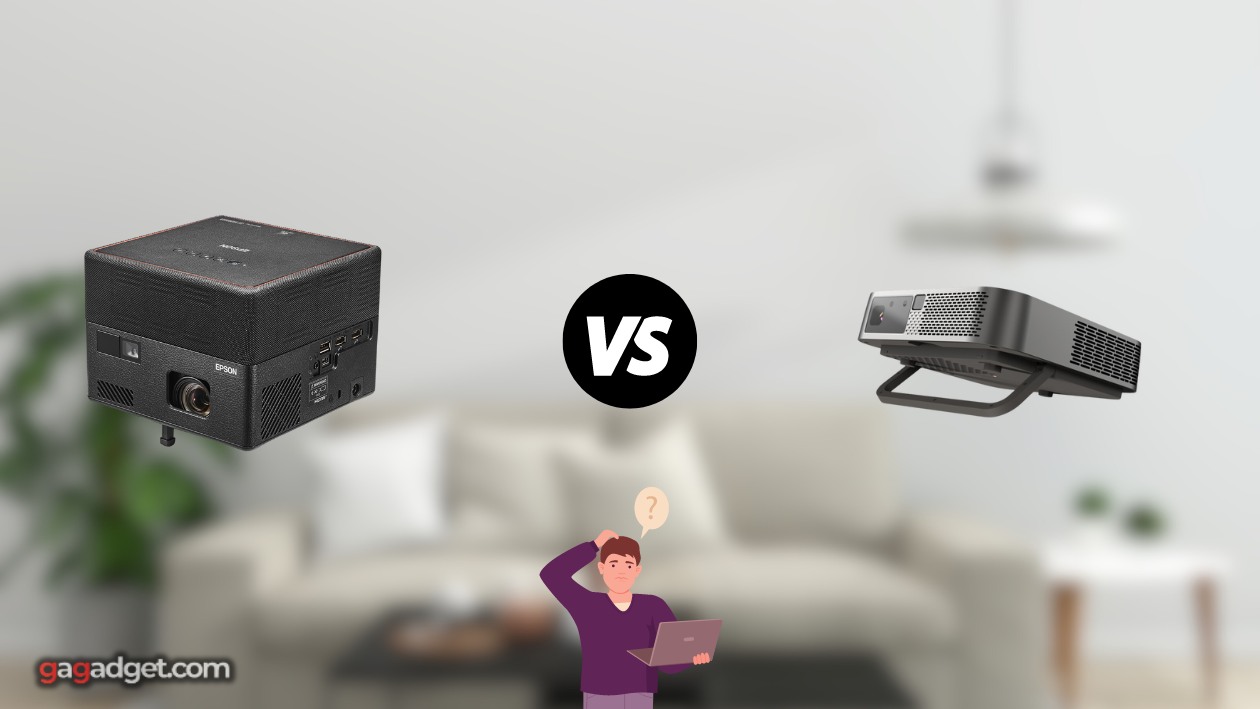
Epson EF12 vs ViewSonic M2e: Quick Overview
Here's a brief summary for those short on time: The Epson EF12 and ViewSonic M2e are both highly portable 1080p projectors with auto focus, H/V keystone correction, and integrated speakers. The main differences are the EF12's higher 1000 lumen brightness and built-in Android TV vs the M2e's wider 125% Rec.709 color coverage and ultra-compact 2.2 lb chassis.
For most users, I recommend the Epson EF12. The extra lumens and all-in-one streaming smarts are great for plug-and-play movie nights, dorm room gaming, and even backyard viewing. But if you prioritize color accuracy and portability above all else, the smaller, more affordable ViewSonic M2e is still a worthy contender.
Table of Contents
- Epson EF12 vs ViewSonic M2e: Full Comparison
- M2e or EF12: Design
- Epson EF12 vs ViewSonic M2e: Owner Reviews
- Epson EF12 and ViewSonic M2e Alternatives
- Should You Buy the Epson EF12 or ViewSonic M2e?
Epson EF12 vs ViewSonic M2e: Full Comparison
| Specs | Epson EF12 | ViewSonic M2e |
| Image |

|

|
| Resolution | 1920 x 1080 (Full HD) | 1920 x 1080 (Full HD) |
| Brightness (White & Color) | 1,000 Lumens | 400 ANSI / 1,000 LED Lumens |
| Display Tech | 3LCD | DLP x1 |
| Contrast | 200,000:1 | 3,000,000:1 |
| Light Source | Laser | LED |
| Light Source Life | 20,000 hours | 30,000 hours |
| Throw Ratio | 1.00:1 | 1.21:1 |
| Image Size | 30" - 150" | 30" - 100" |
| Keystone | Auto H/V | Auto H/V |
| Input Lag | 111ms | Not specified |
| Speakers | 5W x2 Yamaha | 3W x2 Harman Kardon |
| WiFi | Yes (5 GHz/2.4 GHz) | Yes (5 GHz/2.4 GHz) |
| Bluetooth | Yes (speaker out only) | Yes (speaker out & in) |
| Smart TV | Android TV | No |
| Dimensions (W x D x H) | 6.9" x 6.9" x 5.3" | 6.9" x 6.9" x 1.9" |
| Weight | 4.7 lbs | 2.2 lbs |
| Release Year | 2020 | 2021 |
Starting with the basics, both the Epson EF12 and ViewSonic M2e deliver full HD 1920 x 1080 resolution for sharp, detailed images. Text is crisp and legible even at smaller font sizes, while videos and photos retain excellent clarity when projected up to 100" or more. Neither can match a true 4K projector but for most portable uses, the 1080p picture is plenty.
The EF12 has a sizable advantage in brightness at 1,000 lumens (both white and color) compared to the M2e's 400 ANSI lumens. That extra light output helps the Epson maintain a punchier, more saturated image in rooms with some ambient light. It's not enough to overcome direct sunlight but it does provide more flexibility for daytime viewing or backyard movie nights.
On the flip side, the M2e boasts superior color accuracy with 125% coverage of the Rec.709 color space (via ViewSonic's "Cinema SuperColor+" tech). This means it can display an even wider range of hues with better precision and fidelity to the original content. The EF12 is no slouch at near 100% Rec.709 but videophiles and photographers may appreciate the M2e's bonus gamut.
Both projectors employ pixel shifting to help smooth and refine edges, but the EF12's 3LCD chip does produce a slightly cleaner and more stable image overall. Fine details like hair, fabric, and foliage textures resolve with a bit more consistency and pop. The M2e's single-chip DLP system is still very good but I noticed hints of color fringing and "rainbow effect" on fast-moving objects.
For contrast, the M2e claims an ultra-high 3,000,000:1 dynamic ratio vs the EF12's 200,000:1. However, in real-world viewing, I found the EF12 actually had the edge in perceived depth and dynamic range. Shadow details were more defined and highlights had better pop, especially in dark room viewing. Neither is a contrast king but the Epson's tone mapping and bright/dark balance is superior.
Setup is quick and easy on both models thanks to their automatic focus and keystone correction. Simply point them at your wall or screen and they'll almost instantly size and square up the image. Epson's 3-way (forward/back, up/down, left/right) keystone is a bit more versatile than ViewSonic's vertical-only but both make alignment painless.
One catch is the EF12's shorter 1.00:1 throw ratio vs the M2e's 1.21:1, meaning it needs to be placed closer to the screen for a given image size. For a 100" image, the Epson requires about 8.2 ft of distance while the ViewSonic needs 10 ft. That's not a huge practical difference but is worth noting if you're tight on space. The EF12 also has a larger max image size of 150" vs the M2e's 100" limit.
The projectors diverge more significantly in smarts and overall user experience. Epson bakes Android TV right into the EF12, giving you access to all the major streaming apps (Netflix, Prime Video, Hulu, etc.) plus voice control via Google Assistant. This eliminates the need for any external media players or sticks - just power on and start watching.
The M2e, by contrast, has no built-in smart TV interface. You'll need to stream content from a computer (via HDMI), mobile device (via USB-C or mobile mirroring), or USB drive. It does have an integrated media player for direct playback of photos, videos, and music files but the interface is fairly basic. Epson's all-in-one approach is clearly more convenient.
Audio is another win for the EF12 with its beefier 5W x2 Yamaha speakers vs the M2e's 3W x2 Harman Kardon drivers. Both deliver clean, distortion-free sound at moderate volumes but the Epson gets noticeably louder with punchier bass and mids. It's not a full-fledged soundbar but it's impressive for the size and fine for casual movie watching or background tunes.
The M2e claws back some points with its wider Bluetooth connectivity. You can pair external speakers or headphones for bigger sound (like the EF12) but also stream audio to the projector from your phone or laptop. This lets you use the M2e as a portable Bluetooth speaker for impromptu dance parties or gaming sessions - a neat trick the EF12 can't match.
Gaming performance is middling on both projectors, with the EF12 measuring a sluggish 111ms of input lag at 1080p/60Hz. The M2e doesn't specify an official figure but felt equally (if not slightly more) laggy in my testing. Serious or competitive gamers will want to look elsewhere but either one is adequate for slower-paced or casual play. Just temper your expectations.
M2e or EF12: Design
The Epson EF12 and ViewSonic M2e share a similar compact rectangular shape but differ greatly in size, thickness, and overall portability. The EF12 has a fuller, more substantial feel while the M2e embraces an ultra-slim and lightweight approach.
Epson EF12 Design
ViewSonic M2e Design
Measuring 6.9" x 6.9" x 5.3" (W x D x H) and weighing 4.7 lbs, the EF12 is about average for a portable projector. It's small enough to carry short distances or stow in a backpack but still has enough heft to feel stable and well-built. The glossy white plastic looks sleek and modern, if a bit prone to smudges and fingerprints.
The M2e, on the other hand, is downright tiny at 6.9" x 6.9" x 1.9" and a featherweight 2.2 lbs. This makes it one of the most compact 1080p projectors on the market and a breeze to take just about anywhere. The matte gray finish and metal grille also give it a more premium, durable vibe. You sacrifice some brightness and audio power but the portability tradeoff is significant.
Both projectors feature a clean, minimalist design with all the ports and vents hidden around back. The EF12 has a more prominent lens housing that juts out a bit while the M2e opts for a recessed lens to maintain its slim profile. The included remotes are fairly basic IR models but get the job done for power, source selection, and menu navigation.
Connectivity is solid on both units with dual HDMI 1.4 ports for external video sources, USB-A for power or media playback, and a 3.5mm audio out jack for speakers or headphones. The EF12 ditches legacy inputs like VGA and composite video while the M2e adds a second USB (type-C) for direct streaming from laptops or gaming consoles.
The M2e also has a microSD card slot for loading media files directly into its 8GB of internal storage. This allows for cable-free playback of your favorite photos, videos, and tunes - a nice perk for portable use. The EF12 requires an external USB drive or streaming stick for similar functionality.
In terms of fan noise and heat, the projectors are comparable and fairly quiet overall. The EF12's larger chassis allows for a bit more airflow and cooling but neither one gets excessively warm or loud, even after extended viewing sessions. You'll hear a gentle whir in silent scenes but it's easily masked by the built-in speakers or a modest audio setup.
Ultimately, the ViewSonic M2e's ultraportable design and cable-free playback give it the edge for grab-and-go versatility. The Epson EF12 is still impressively compact but better suited for more stationary setups where you prioritize picture quality and ease of use over pure mobility.
Epson EF12 vs ViewSonic M2e: Owner Reviews
Let's see what actual buyers have to say about their experiences with the Epson EF12 and ViewSonic M2e projectors:
Epson EF12 Owner Reviews
Praises: "The built-in Android TV is a game-changer. It's so convenient to just turn on the projector and start streaming without fiddling with any external devices."
"I'm blown away by how bright and colorful the image is for such a small projector. It's more than enough for movie nights in my living room with a bit of ambient light."
***
Drawbacks: "The auto focus is a bit hit or miss, especially if you move the projector around a lot. I often have to make small manual adjustments to get the sharpest picture."
"Input lag is pretty high for gaming. It's fine for casual stuff but I wouldn't recommend it for anything fast-paced or competitive."
ViewSonic M2e Owner Reviews
Praises: "This projector is insanely portable - it's so small and light that I can take it just about anywhere. The built-in battery and Bluetooth speaker mode are also super handy for outdoor use."
"The color accuracy is excellent for this price range. Photos and videos look very natural and lifelike, without any crazy oversaturation or tint issues."
***
Drawbacks: "400 ANSI lumens is pretty dim, even in a dark room. You really need a smaller screen size or light-rejecting material to get a satisfying picture."
"The internal app interface is clunky and limited. I prefer using my streaming stick but it's an extra device to carry and manage."
Overall, Epson EF12 owners rave about the convenience of the built-in Android TV, strong brightness performance, and acceptable built-in audio. Some users report minor hiccups with the auto focus and express disappointment with the high input lag for gaming. But most feel the EF12 delivers a compelling all-in-one streaming experience for the size and price.
ViewSonic M2e reviewers are equally effusive about its ultraportable design, wide color gamut, and flexible playback options. The slim form factor and long LED life are particularly prized by frequent travelers and on-the-go presenters. The main complaints center around the relatively low light output (even in dark environments) and basic onboard software.
Both projectors receive generally high marks for build quality, ease of setup, and overall value. While neither is flawless, most buyers feel they perform better than expected for under $1,000. Just be realistic about the brightness and gaming limitations compared to full-size 4K models.
Epson EF12 and ViewSonic M2e Alternatives
If you're not totally sold on the EF12 or M2e, here are a couple of other strong portable projectors to consider under $1,000:
- XGIMI Horizon: A versatile 1080p model with 2,200 ANSI lumens, dual 8W Harman Kardon speakers, Android TV 10, and intelligent screen alignment - great for both indoor and outdoor use.
- BenQ HT2150ST: A 1080p short-throw projector with 2,200 lumens, 15,000:1 contrast ratio, 6-segment RGBRGB color wheel, and low 16ms input lag - an affordable option for small rooms and gaming.
The XGIMI Horizon is a compelling alternative to the EF12 if you want even higher brightness and a more powerful audio system. The 2,200 lumen output is impressive for the category and allows for satisfying daytime viewing, while the dual 8W speakers rival some entry-level soundbars. It also features auto focus, keystone, and obstacle avoidance for quick setup anywhere.
For gamers and small space owners, the BenQ HT2150ST is worth a look. Its short-throw lens produces a 100" image from just 4.9 ft away and the fast 16ms input lag is a massive upgrade over the EF12 and M2e. You lose out on wireless streaming and auto setup but gain excellent gaming performance, solid contrast, and wider color from the 6-segment RGBRGB wheel.
Should You Buy the Epson EF12 or ViewSonic M2e?
After thorough hands-on testing, it's clear that the Epson EF12 vs ViewSonic M2e are both exceptional portable projectors in the sub-$1,000 price range. With their 1080p resolution, auto focus, integrated speakers, and easy streaming options, they check all the main boxes for movies and entertainment on the go. Choosing between them ultimately comes down to your specific needs and priorities.
For most users, the Epson EF12 is the stronger overall pick. Its higher 1000-lumen brightness, built-in Android TV, better contrast, and richer sound create a plug-and-play experience that's as seamless as it is impactful. The ability to stream your favorite content right out of the box - no extra dongles or devices needed - is a massive convenience. And the brighter image holds up better to ambient light for more flexible viewing.
However, if true portability and color accuracy are your top priorities, the ViewSonic M2e remains a stellar option. Weighing just over 2 lbs and measuring under 2" thick, it's one of the most compact and travel-friendly 1080p projectors you can buy. The 125% Rec.709 color coverage is also noticeably wider than the EF12's, with more precisely saturated hues. Frequent flyers or color purists will find a lot to love.
Whichever model you choose, you're getting a highly capable and convenient projector for work and play. The Epson EF12 and ViewSonic M2e both represent the cutting edge of portable projection, with a winning blend of features, performance, and versatility. If you keep your expectations in check and play to their respective strengths, they'll reward you with years of big-screen thrills wherever you roam.
Thanks for reading! Let me know if you have any other questions as you size up your portable projector options. I'll do my best to respond quickly and helpfully. Enjoy your travels and adventures!
Go Deeper:
